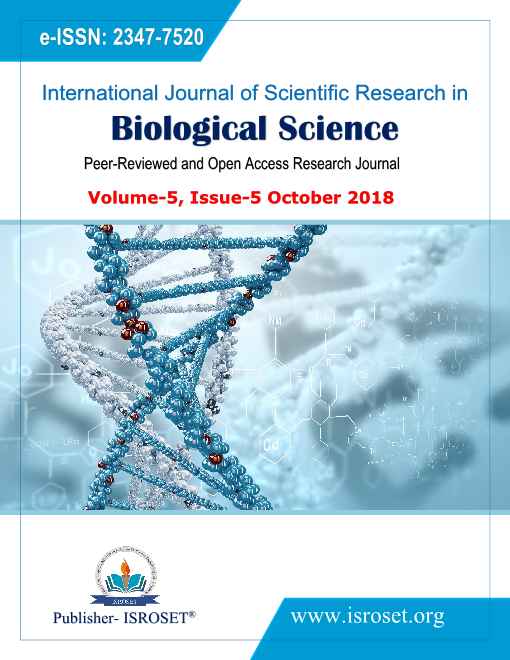Biogenic synthesis of silver nanoparticles using pigment producing Streptomyces sp and Its drug binding assay
Keywords:
Drug, Streptomyces sp, Melanin, microwave radiation, silver nanoparticlesAbstract
Cardiovascular disease, management of hypertension is mostly treated by Amlodipine, atorvastatin and telmisartan. Amikacin also one of the pharmaceutical drugs against bacterial infections. The Streptomyces sp. DSK2 melanin absorbs the drugs in different concentration, different temperature and different incubation timings. The result shows that the Streptomyces sp. DSK2melanin absorb the drugs in 40◦C and the reaction timings were 180min. Amlodopine bind strongly at 40◦C at180 min, other two drugs Atorvastatin and Amikacin moderate bind at 40◦C at 120 min. Other biomedical studies of the Streptomyces sp. DSK2 melanin silver nanoprticle was synthesized in 180s by the microwave radiation method. The silver nanoparticle range 50nm in size, which is confirmed by TEM analysis, UV spectrum at 420nm , FTIR Spectrum , XRD. The melanin showed the potent antioxidant activity was determined by DPPH assay, the maximum activity was 87.96 and the total antioxidant activity phosphomolybdate assay) was 88.05. in this study, Streptomyces sp. DSK2 Melanin has great biomedical activity.
References
Larsson B.S.: “Pigment Cell Res”- 6, 127 (1993).
Hong L., Simon J.D.: J. Phys. Chem. B. 111, 7938 (2007).
Liu, Y. T., M. J. Sui, D. D. Ji, I. H. Wu, C. Chou, and C. C. Chen. “Protection from UV irradiation by melanin of mosquitocidal activity of Bt. var. Israeliensis”. J. Invertebr. Pathol. 62: 131-136. 1993.
Larsson BS , “Interaction between chemicals and melanin”. Pigment Cell Res 6:127–133.
Zane P, Brindle SD, Gause D, O’Buck AJ, Raghavan PR, Tripp SL, “Physicochemical factors associated with binding and retention of compounds in ocular melanin of rats: correlations using data from whole-body autoradiography and molecular modeling for multiple linear regression analyses”. Pharm Res 7:935–941, 1990
Atlasik B, Stephen K, Wilczok T ,” Interaction of drugs with ocular melanin in vitro”. Exp Eye Res 30:pp 325–33,1980
Debing I, Ijzerman AP, Vauqelin G, “Melanosome binding and oxidation-reduction properties of synthetic L-dopa-melanin as in vitro tests for drug toxicity”. Mol Pharmacol 33:470–476, 1988
Shimada K, Baweja R, Sokoloski T, Patil PN, “ Binding characteristics of drugs to synthetic levodopa melanin”. J Pharm Sci 65:1057–1060, 1976.
Buszman E., Wrzeuniok D., Trzcionka J.: Pharmazie 62, 210 ,2007.
Wrzeuniok D., Buszman E., Karna E., Paka J.: Pharmazie 60, 439 (2005).
Wrzeuniok D., Buszman E., Lakota D.: Acta Pol. Pharm. Drug Res. 68, 493 (2011).
M.M. Salazar-Bookaman, I. Wainer, P.N. Patil, J. Ocul. Pharmacol. Vol.10 , 217-220 ,1994.
N.G. Lindquist, S. Ullberg, Acta Pharmacol. Toxicol (Copenh.) 2(Suppl) 1972.
Nordberg G.F., Fowler B.A., Nordberg M.,Friberg L.: “Handbook on the Toxicology of
Metals”. 3rd edition., pp. 6- 8, Elsevier, Amsterdam 2007.
Huang J, Chen C, He N, Hong J, Lu Y, Qingbiao L, Shao W, Sun D, Wang XH, Wang Y, Yiang,“Biosynthesis of silver and gold nanoparticles by novel sundried Cinnamomum camphora Leaf”. Nanotechnology Issue-18: pp-105–106., 2007.
Rai M, Yadav A, Gade A, “Current trends in phytosynthesis of metal nanoparticles. Crit Rev
Biotechnology”. 28(4):277–284, 2008
Husseiny MI, El-Aziz MA, Badr Y, Mahmoud MA,”Biosynthesis of gold nanoparticles
using Pseudomonas aeruginosa”. Spectrochim Acta A: Mol Biomol Spectrosc 67: pp- 1003–1006, 2007.
Shahverdi AR, Minaeian S, Shahverdi HR, Jamalifar H, Nohi AA, “Rapid synthesis of silver
nanoparticles using culture supernatants of Enterobacteria: a novel biological approach”.
Process Biochem 42: pp-919–923, 2007.
Kumar V, Yadav SK ,”Plant-mediated synthesis of silver and gold nanoparticles and their
Applications”. J Chem Technol Biotechnol 84:pp- 151–157, 2009.
Parikh RY, Singh S, Prasad BLV, Patole MS, Sastry M, Shouche YS, “Extracellular synthesis of crystalline silver nanoparticles and molecular evidence of silver resistance from Morganella sp: towards understanding biochemical synthesis mechanism”. ChemBioChem .9:pp- 1415–1422, 2008.
Gajbhiye M, Kesharwani J, Ingle A, Gade A, Rai M, “Fungus-mediated synthesis of silver nanoparticles and their activity against pathogenic fungi in combination with fluconazole.Nanomed” Nanotechnol Biol Med vol-5:pp-382–386.2009.
Ahmad A, Senapati S, Khan MI, Kumar R, Ramani R, Shrinivas V, Sastry M,”Intracellular synthesis of gold nanoparticles by a novel alkalotolerant actinomycete, Rhodococcus species”.Nanotechnology vol-14:pp-824–828, 2003b.
Shahi SK, Patra M, “Microbially synthesized bioactive nanoparticles and their formulation active against human pathogenic fungi". Rev Adv Mater Sci 5:501–509, 2003.
Singaravelu G, Arockiamary JS, Ganesh Kumar V, Govindraju K, “A novel extracellular synthesis of monodisperse gold nanoparticles using marine alga, Sargassum wightii Greville”.Colloid Surf B: Biointerface 57: pp-97–101, 2007.
Chakraborty N, Banerjee A, Lahiri S, Panda A, Ghosh AN, Pal R, “Biorecovery of gold using cyanobacteria and eukaryotic alga with special reference to nanogold formation – a novel phenomenon”. J Appl Phycol 21(1):145–152, 2009.
Gade AK, Bonde P, Ingle AP, Marcato PD, Duran N, Rai MK, “Exploitation of Aspergillus niger for synthesis of silver nanoparticles". J Biobased Mater Bioenergy 2:pp- 243–247, 2008.
Mukherjee P, Ahmad A, Mandal D, Senapati S, Sainkar SR, Khan MI, Ramani R, Parischa R, Ajayakumar PV, Alam M, Sastry M, Kumar R ,”Bioreduction of AuCl4ions by the fungus Verticillium sp and surface trapping of the gold nanoparticles formed”. Angew Chem Int Ed 40(19): pp-3585–3588, 2001.
J. Gallas, M. Eisner, Melanin polyvinyl alcohol plastic laminates for optical applications, US Patent7029758 , 2006.
Downloads
Published
How to Cite
Issue
Section
License

This work is licensed under a Creative Commons Attribution 4.0 International License.
Authors contributing to this journal agree to publish their articles under the Creative Commons Attribution 4.0 International License, allowing third parties to share their work (copy, distribute, transmit) and to adapt it, under the condition that the authors are given credit and that in the event of reuse or distribution, the terms of this license are made clear.







